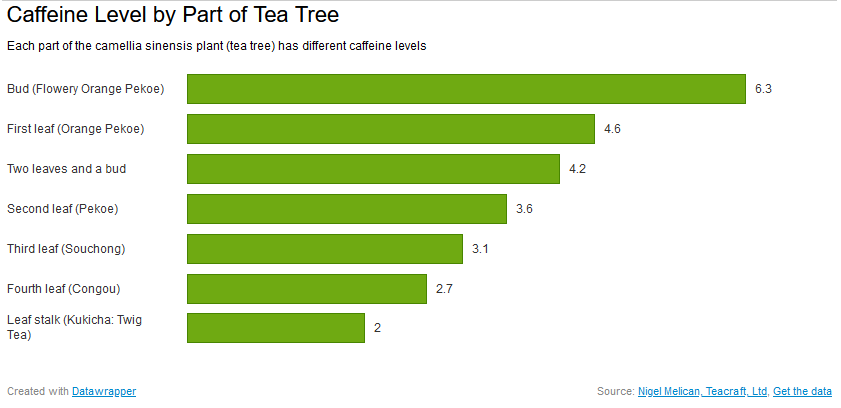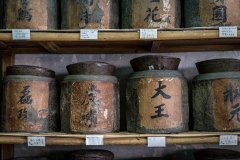How much caffeine is there in the tea? What are the effects and effects of caffeine? Decaffeinated Bols tea
Contrary to popular belief, black tea does not always contain more caffeine than green, white or oolong tea. In fact, some green and white teas contain more caffeine than black teas.

The amount of caffeine has more to do with the part where it comes from the tea tree. The top core contains the most caffeine. The top leaves have the second highest caffeine content. Larger, lower leaves contain the least caffeine.
Generally speaking, high-end tea will have more buds. A cup of tea with a strong taste will use the lower leaves of the tea tree. Surprisingly, the strongly smoked Zhengshan race has lower caffeine content than white tea such as silver needles.
Of course, there are other factors that affect the amount of caffeine in tea, such as soaking time and temperature.
The following picture shows the caffeine content of each part of the leaf:

But some people, do not like the existence of caffeine, do not want to eat caffeine, but want to drink tea.
Every time you make tea, caffeine is consumed and dissolved in water. The question is, how much is left after the second and third soaking? Can you really remove most of the caffeine from the tea by rinsing?
Traditional methods of removing caffeine from tea
Soak the tea in hot water for 30 seconds
Water injection
Make the tea again.
Now 80% of the caffeine is ruled out, right? According to a study by Dr. Bruce Branan, a chemistry professor at Wilmore, KY, it takes three minutes for a cup of tea to remove 46-70% of the caffeine.
Another interesting thing is that a Chinese white tea has the second highest caffeine content, second only to Assam black tea, indicating that oxidation does not affect the caffeine content of the tea.

The data above show that in the first tea, Assam black tea contains more caffeine than white peony white tea, while the third is Indian green tea, followed by Kenyan green tea, Sri Lankan black tea, Darjeeling, and finally Tieguanyin oolong tea.

The caffeine content of the second tea, Assam black tea has a great change to the third.

By the third bubble, the caffeine content of each kind of tea decreased significantly. However, it should be noted that with the decline of caffeine content, there is little substance left in tea leaves. Therefore, as the amount of caffeine precipitated decreases, there are few flavor and flavor substances left, and the amount of caffeine that can be precipitated is certainly small.
If you are a small companion in pursuit of flavor, taste and taste, it is not advisable to use this method to reduce the caffeine content in the tea. The decrease in caffeine content is accompanied by the loss of aroma and taste in tea. Of course, there are also some decaffeinated teas, such as scented tea, herbal tea, spiced tea, or South African specialties, their national treasure tea, Bols tea.
It is worth noting that a moderate amount of caffeine has many benefits to the body, and now there are many scientific research papers to support this. As long as you consume no more than 400 milligrams of caffeine a day, isn't it a good thing to have a little caffeine to make the whole day more energetic?
Important Notice :
前街咖啡 FrontStreet Coffee has moved to new addredd:
FrontStreet Coffee Address: 315,Donghua East Road,GuangZhou
Tel:020 38364473
- Prev

How to preserve the tea after it is bought? the best preservation method is recommended for tea maintenance.
Storing tea, herbal tea, herbal tea and other types has always been an annoyance to ordinary consumers. "for how long, how to put it, where to store it, and whether to use different utensils" are the most frequently asked questions. For tea drinkers of ordinary consumers, although they do not have to reach the high standard of old Pu'er tea and aged oolong tea, the goal is expected to be a high-standard environment for decades.
- Next

What is Fat American Coffee? Taste characteristics of fat American production method Chemical reaction between Coffee and Coke
Coffee and coke, sounds like a bad idea? No no no! Many people have tried this seemingly dark match. It has also been given a lovely Chinese name Fat American style! Interestingly, although Coca-Cola is an American-made drink, Feimei seems to have originated in South Korea and Taiwan. Fat Americano combines classic Coca-Cola and espresso perfectly.
Related
- Beginners will see the "Coffee pull flower" guide!
- What is the difference between ice blog purified milk and ordinary milk coffee?
- Why is the Philippines the largest producer of crops in Liberia?
- For coffee extraction, should the fine powder be retained?
- How does extracted espresso fill pressed powder? How much strength does it take to press the powder?
- How to make jasmine cold extract coffee? Is the jasmine + latte good?
- Will this little toy really make the coffee taste better? How does Lily Drip affect coffee extraction?
- Will the action of slapping the filter cup also affect coffee extraction?
- What's the difference between powder-to-water ratio and powder-to-liquid ratio?
- What is the Ethiopian local species? What does it have to do with Heirloom native species?

